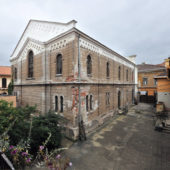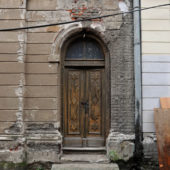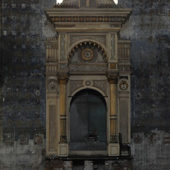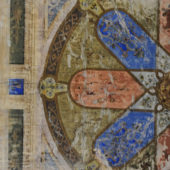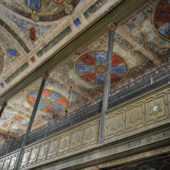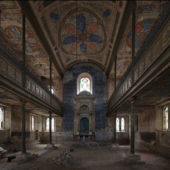Although this deteriorating synagogue has been replaced with a newer one, the painted interior is still very beautiful.
The center of Jewish communal life in Kosice is a compound located only a city block from the city center. It is in an area developed after the city fortifications were destroyed in the mid-19th century. In front of the compound there is a bronze plate memorializing the 12,000 Jews from Kosice transported to the concentration camps in WWII. Only 400 survived. The compound includes the old synagogue building, a mikvah (ritual bath), which dates back to the mid 19th century, offices of the Jewish community and rabbinate, a kosher cafeteria, and a small synagogue which is still in use for regular services.
The old Kosice Orthodox synagogue stands empty and after decades of disuse and neglect is only used for occasional storage. Janos Balog designed the impressive building, which was constructed in 1899. Its empty interior is solemn, with most wall and ceiling surfaces covered with richly decorative wall paintings in geometric and repetitive Moorish motifs. The Aron Kodesh and a basin are all that remain of the furnishings. This synagogue is currently undergoing restoration and will eventually house the Memorial Museum of Eastern-Slovak Jewish Communities; inauguration is hoped to take place in 2013, when Kosice will be the European Capital of Culture.
The first Jews settled in Kosice in 1843 yet they have lived in the Slovakian region since the 11th century. By the 14th century, nearly 800 lived in Bratislava, most of whom were engaged in commerce and money lending which were among the few occupations open to them. Two notorious blood libels occurred in Slovokia for which Jews were blamed. In 1494 Jews were burned at the stake in Trnava and in 1529 in Pezinok, 30 Jews were burned at the stake. Subsequently, after the battle of Mohacs in 1526, Jews were expelled from all major towns of Slovakia.
During the late 17th century and early 18th century, Jews began returning to Slovakia, and established communities. However, they were in constant conflict with locals and were banned from many trading industries. Under the rule of Joseph II, Jews were granted many civil liberties and their livelihoods were enhanced. In 1683 hundreds of Moravian Jews fled the Kurucz riots to Slovakia. These people mainly settled along the western border of Slovakia, near the Moravian border. In 1700 the leading yeshiva was founded in Bratislava, which was recognized by the government for the education of rabbis. In 1867 the dual-monarchy of Austro-Hungary was established and Slovakia became part of Hungary, often nicknamed “northern Hungary.”
For over 1,000 years, Hungarian Jewry was tied closely with Slovakian Jewry. The Hungarian parliament passed the Emancipation Law to promote assimilation among minorities, particularly Jews. Government officials supported Jewish work in industry and finance. Therefore, the Jewish population grew exponentially, particularly in small, secluded towns in Eastern Slovakia. However, anti-Semitism continued to be a problem and nationalists refused to allow Jews to assimilate into their culture.
In 1882 and ‘83 anti-Jewish riots took place in several towns in Slovakia. In 1896 the “Reception Law” was passed, placing Judaism and Christianity on the same level. The Slovak Clerical People’s Party was formed, whose main purposes were anti-liberalism and limiting Jewish influence in the country. Zionism rose in the 19th century. Eight local Zionist organizations were formed in Slovakia. In 1903, Bratislava held the first Hungarian Zionist Convention and the first World Mizrachi Congress was convened in 1904.
In 1918, following World War I, Czechoslovakia was created. The Jewish people were given the right to be considered a separate nationality within the country, not only in industry, but in cultural life. In 1919 the National Federation of Slovak Jews was established and the Jewish Party was also founded. In the first national census of Czechoslovakia, 135,918 people registered themselves as practicing Jews, 70,522 declared themselves of Jewish nationality. Before WWII there were 217 Jewish congregations in Slovakia, 165 Orthodox and the remaining 52 split between Neolog (Reform) and Status Quo Ante.
Prior to WWII, 11,500 Jews lived in Kosice, making up 16.4% of the city’s total population. Under the protection of Nazi Germany, Slovakia proclaimed its independence in March 1939. The first anti-Jewish law was passed in Slovakia in April of that year. A few days later, Jews were excluded from all government positions and service. By September 19, 1939, all Jews were expelled from the military. Anti-Semitism increased, including the expulsion of Jewish children from school. By 1940, over 6,000 Jews had emigrated either legally or illegally. Germans continued passing more restrictive laws, decreasing Jews’ rights in Slovakia. On September 9, 1941, Jews were met with a proclamation of 270 articles, including having to wear a yellow armband with a Star-of-David, and forced labor camps. Soon thereafter they began being sent to concentration camps for annihilation. By 1942, nearly three-quarters of all Slovakian Jewry had been exterminated. Only 25,000 Slovakian Jews survived the Holocaust. Many subsequently emigrated to Israel or the United States.
Communist rule continued until 1992. Slovakia gained its independence on January 1, 1993. Since that time, Jewish organizations such as Maccabi and B’nai B’rith have been reborn. Today, 6,000 Jews live in Slovakia and 280 in Kosice, the city with the second largest Jewish community in Slovakia today.

